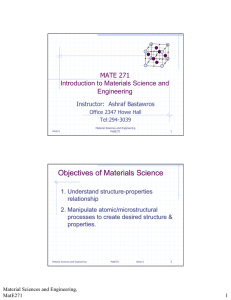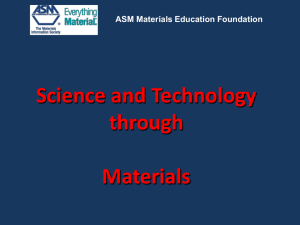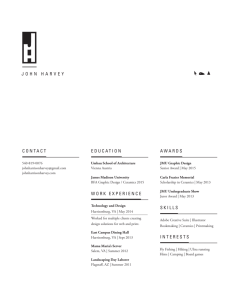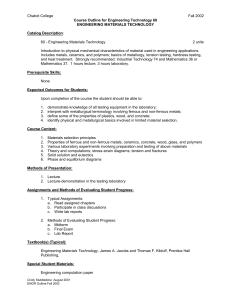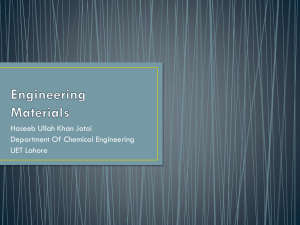MODULE DESCRIPTOR MECH3012 - Production Engineering and Non-metallic Materials
advertisement
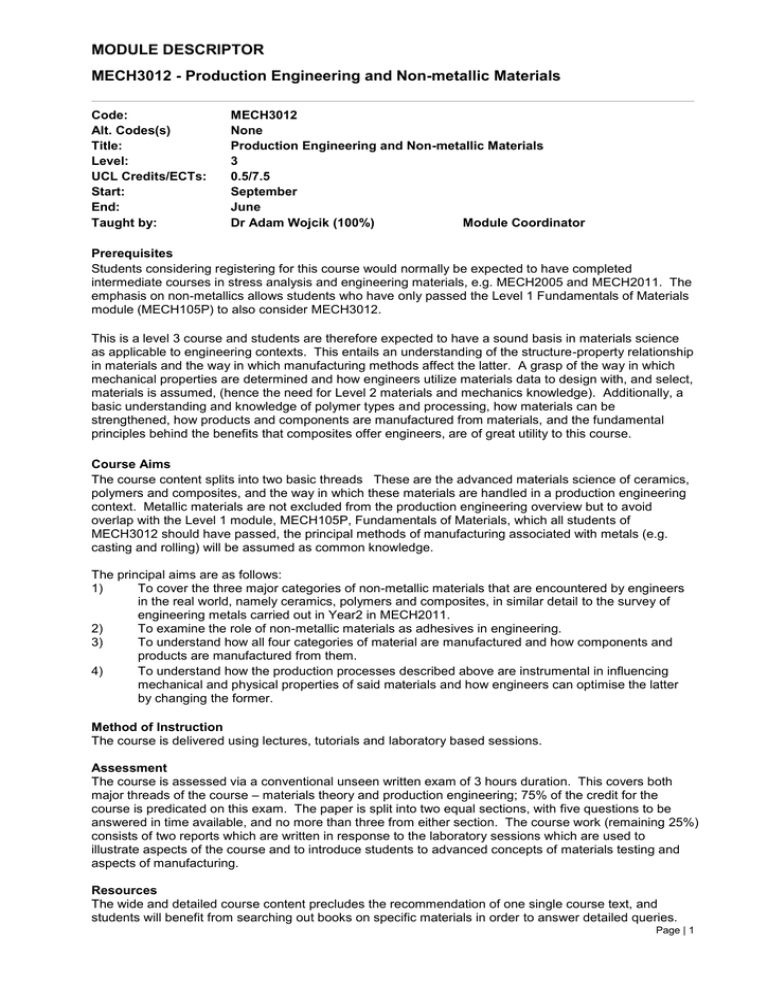
MODULE DESCRIPTOR MECH3012 - Production Engineering and Non-metallic Materials Code: Alt. Codes(s) Title: Level: UCL Credits/ECTs: Start: End: Taught by: MECH3012 None Production Engineering and Non-metallic Materials 3 0.5/7.5 September June Dr Adam Wojcik (100%) Module Coordinator Prerequisites Students considering registering for this course would normally be expected to have completed intermediate courses in stress analysis and engineering materials, e.g. MECH2005 and MECH2011. The emphasis on non-metallics allows students who have only passed the Level 1 Fundamentals of Materials module (MECH105P) to also consider MECH3012. This is a level 3 course and students are therefore expected to have a sound basis in materials science as applicable to engineering contexts. This entails an understanding of the structure-property relationship in materials and the way in which manufacturing methods affect the latter. A grasp of the way in which mechanical properties are determined and how engineers utilize materials data to design with, and select, materials is assumed, (hence the need for Level 2 materials and mechanics knowledge). Additionally, a basic understanding and knowledge of polymer types and processing, how materials can be strengthened, how products and components are manufactured from materials, and the fundamental principles behind the benefits that composites offer engineers, are of great utility to this course. Course Aims The course content splits into two basic threads These are the advanced materials science of ceramics, polymers and composites, and the way in which these materials are handled in a production engineering context. Metallic materials are not excluded from the production engineering overview but to avoid overlap with the Level 1 module, MECH105P, Fundamentals of Materials, which all students of MECH3012 should have passed, the principal methods of manufacturing associated with metals (e.g. casting and rolling) will be assumed as common knowledge. The principal aims are as follows: 1) To cover the three major categories of non-metallic materials that are encountered by engineers in the real world, namely ceramics, polymers and composites, in similar detail to the survey of engineering metals carried out in Year2 in MECH2011. 2) To examine the role of non-metallic materials as adhesives in engineering. 3) To understand how all four categories of material are manufactured and how components and products are manufactured from them. 4) To understand how the production processes described above are instrumental in influencing mechanical and physical properties of said materials and how engineers can optimise the latter by changing the former. Method of Instruction The course is delivered using lectures, tutorials and laboratory based sessions. Assessment The course is assessed via a conventional unseen written exam of 3 hours duration. This covers both major threads of the course – materials theory and production engineering; 75% of the credit for the course is predicated on this exam. The paper is split into two equal sections, with five questions to be answered in time available, and no more than three from either section. The course work (remaining 25%) consists of two reports which are written in response to the laboratory sessions which are used to illustrate aspects of the course and to introduce students to advanced concepts of materials testing and aspects of manufacturing. Resources The wide and detailed course content precludes the recommendation of one single course text, and students will benefit from searching out books on specific materials in order to answer detailed queries. Page | 1 The books listed below should prove useful as a method of supplementing lecture notes. The list is not exhaustive and a range of books need to be sought out. The list begins with general “background” books, which students should already have from their Level1 and 2 courses, but also includes those detailed texts relevant to the course. Materials Science & Engineering. An Introduction*. (8th/7th ed). W. D. Callister & D. G. Rethwisch. Wiley. Hardback with good coverage of most topics, both have an associated CD or web access. You may already have this book from Year1/2. Its general coverage of polymers and composites is quite good. The Science and Engineering of Materials*. (4th ed.) D. R. Askeland & P. P. Phule. Thompson (4th ed). Hardback, covers more than Callister but less deeply in some places, good on ceramics and polymers, comes with CD. An Introduction to Materials Science for Engineers. (7th or 6th ed). J. F. Shackelford. Pearson. Up to date general text with emphasis on engineering applications. Better on processing methods than the two above. Engineering Materials, Properties and Selection, 9th or 8th ed., K. G. & M. K. Budinski. Pearson. Very good on how & why materials are used, less good on theoretical aspects. Specific books on non-metallics Fundamentals of Ceramics, M. W. Barsoum, (2nd or 1st ed 2003) IOP Publishing Brilliant little book on the theory of ceramics. Physical Ceramics, M Chiang et al, Wiley, (1st ed 1997) Theory based, heavy, but the final word. Polymer Materials, C Hall, Macmillan (2nd ed, 1989) A compact introduction to polymer theory including mechanical properties. Plastics, Materials and processing, A B Strong, Prentice Hall, (2nd ed 2000), Very good on processing, poor on theory. Structural Materials, G Weidmann et al, Butterworth/OU, (1st ed 1990). An excellent introduction to the theory and uses of composites, ceramics, & polymers, sadly out of print. Joining Processes, D Brandon, W Kaplan, Wiley (1st ed 1997). OK introduction to sticky stuff, not brilliant. Specific books on production engineering and manufacturing Introduction to Manufacturing Processes. (3rd ed). J. A. Schey. McGraw Hill. (good coverage and nicely updated from the 2nd ed). Manufacturing Engineering and Technology. (6th or 5th ed). S Kalpakjian, S. R. Schmid. Pearson/Prentice Hall. Excellent book, bang up to date. Additional Information Although the structure of the course is designed to cover two distinct areas, the material is always delivered together. Students should therefore treat teh course material as a continuum, but note that in the end of year exam, the paper is divided into two sections – each one focussing on aspects of the two way split of the course. Give the advanced level of the course, there is an expectation that some “reading around” this delivered matter occurs. Content 24 lectures + 6 tutorials 1x lab (Spring term, Strength of ceramics/glass) The lectures are supported by pictorial hand-outs and a weekly thought provoking problem (with a detailed worked solution supplied the following week). Adhesives: Theory and joint design. Selection and types. Production processes and procedures for long term bond integrity. Ceramics: Common structures, e.g. of silicates and glasses. Phase diagrams, types of defects present in microstructures. Important mechanical properties. Brittle fracture, elastic and plastic behaviour, high temperature behaviour, creep, influence of porosity and processing. Preparation and production of ceramics, glasses & glass ceramics. Importance of temperature in these (including glass and its heat treatment, glass ceramics, firing and sintering of engineering ceramics). Influence of production Page | 2 method upon mechanical properties such as strength and creep behaviour. Advanced applications. Methods of toughening ceramics and glasses, including transformation toughening. Polymers: Recap of structure, polymerisation, manufacturing methods. Influence of molecular weight, branching, cross linking etc. Crystalline versus glassy structure. Influence of structure on mechanical properties. Influence of manufacturing method on structure. Viscoelasticity theory, other deformation mechanisms inc. creep. Review of types, classes, additives and their effect. Degradation mechanisms. Composites: Review of classes and brief theory. Particle and fibre composites. Failure mechanisms, Advanced uses. Methods of production and manufacture of composites and composite structures Metal and ceramic matrix composites, honeycomb structures. Basic cement and concrete, reinforced concrete, macro defect free cement. Fibres: Polymer, glass and carbon, fibres assemblies and ropes. Case study: Selected from space shuttle tiles, hip joints or bullet proof armour. General Learning Outcomes Knowledge and Understanding Basic science applied to ceramics, polymers and composites and the structure property relationships of these materials; the utilisation of these materials in engineering applications, their attributes and limitations; processing techniques and its impact on material properties. Skills and Attributes (i) Intellectual Selection of appropriate non-metallic material for specific engineering application; select processing methods to confer improvement in performance characteristics; appreciation of environmental impact of processing and disposal. (ii) Practical Use mechanical test equipment to characterise properties of non-metallic and metallic materials; utilise material database for the selection of appropriate materials in engineering design; use of analytical methods to determine design with and select materials. (iii) Transferable Undertake appropriate materials selection from a wide set of data; interpret experimental results and communicate this effectively in a written report. Page | 3
